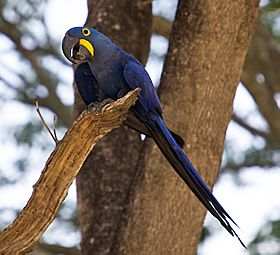Hyacynth macaw facts for kids
Quick facts for kids Hyacinth macaw |
|
|---|---|
| Hyacinth macaw | |
| Scientific classification | |
| Kingdom: | |
| Phylum: | |
| Class: | |
| Order: | |
| Family: | |
| Genus: |
Anodorhynchus
|
 |
|
| Distribution of Hyacinth macaw | |
The hyacinth macaw (Anodorhynchus hyacinthinus) is a large, beautiful parrot. It lives in central and eastern South America. These amazing birds are known for their bright blue feathers. They are the longest parrots in the world.
From the top of their head to the tip of their long tail, they can be about 100 cm (3.3 ft) long. This makes them the biggest macaw and the largest flying parrot species. Sadly, the hyacinth macaw is an endangered species. This means there are not many left in the wild.
What Hyacinth Macaws Eat
Hyacinth macaws have a special diet. They mostly eat nuts from native palm trees. Their beaks are very strong and powerful. They can easily crack open tough nuts and seeds.
Their tongues are dry and smooth. They even have a small bone inside them. This helps the macaws tap into fruits. One nut they love is the acuri nut. It is so hard that the parrots can only eat it after it has passed through a cow's stomach! Besides nuts, they also enjoy fruits and other plant matter. Their diet includes nectar and different kinds of seeds. They travel far to find ripe food.
Why Hyacinth Macaws Are Endangered
The hyacinth macaw faces many dangers. Their numbers have dropped a lot in the wild. This is mainly because of two big problems.
One problem is that their homes are being destroyed. Forests where they live are cut down. This leaves them with nowhere to live or find food. Another major threat is people illegally catching them. These birds are often caught to be sold as pets. Their beautiful feathers are also sometimes taken illegally.
Natural Challenges for Reproduction
In the wild, hyacinth macaw eggs can be eaten by other animals. Small mammals, vultures, and even toucans sometimes eat their eggs. Toucans eat about half of the macaw's eggs.
However, toucans are also very important for the macaws. Toucans help spread the seeds of the Manduvi tree (Sterculia apetala). This tree is perfect for macaws to build their nests. There are not many other good places for them to nest. Toucans spread most of the Manduvi tree's seeds. This shows how nature is connected, even if it seems a bit strange!


